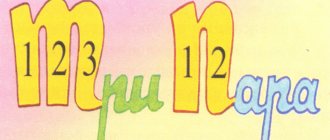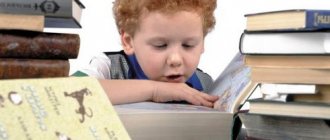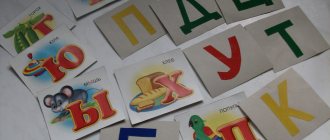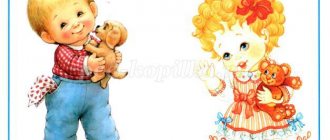Differentiation of vowels of the first and second row
Lesson notes
Subject. Differentiation of vowels of the first and second row. Target. Teach children to distinguish vowels s
- both orally and in writing.
Equipment. Text of the poem by S. Pogorelovsky “Oh and the problems in Mishka’s notebook”, table with vowels of the first and second row.
Progress of the lesson
I. Organizational moment.
The speech therapist invites students to remember and name the vowels of the first and second row.
II. Repetition of previously covered material.
The speech therapist invites students to remember how vowels of the second kind are formed. Posts a table with vowels of the first and second row.
| A | 0 | U | uh | s |
| I | e | Yu | e | And |
Offers to compare pairs of vowels: a
-
I, o
-
e, u
-
y, e
-
e, s - i.
The similarity of these pairs in articulation and the difference in spelling are revealed.
“These vowels are called paired vowels. In order not to confuse them when writing, we will learn to distinguish between them,” says the speech therapist.
III. Working with a poem.
The speech therapist reads a poem.
- What are you looking at, cow, Strictly and sternly?
— Teddy Bear with an “a” Written by a cow, Write it by you
Teddy bear with “s”, Teach Teddy bear a lesson - Turn it into a mouse. Cat grab mouse! There will be a quitter to know.
The speech therapist invites children to compare the words Mishka
and
a mouse
in meaning and spelling. Writes these words on the board. He asks what letters differ in the spelling of these words.
IV. Differentiation _
- and in syllables.
1. Listen to the syllables. Say what vowel you hear.
a) Py, you, we, sy, ry, dy, would, ky;
b) pi, ti, mi, si.ri, di, bi, ki.
“How are the consonants you heard first and then pronounced? (Hard, soft.)
What sound here indicates the softness of the consonants? - asks the speech therapist.
2. Repeat the syllables after the speech therapist.
Py
-
pi
-
pi, ti
-
you
-
ti, sy
-
sy
-
ei, ri
-
ry
-
ry" dy -
di -
dy.
3. Write the syllables in two lines: sy - in the first, si - in the second.
We, si, sy, mi, ry, ri, ti, you, ky, ki, li, pi, py, ly.
. Task 4. Complete the words by inserting the syllables given in brackets.
Gri...(o's), li...(ly), le...(tsh), bo...(would),
ru...(/sh), ry...(by), la...(gay), but...(gy),
book...(gi), so...(you), ke...(dy), be...(gi),
ke -
d...(ry),
ko...(you),
ka...(ti).
V. Summary of the lesson.
The speech therapist asks the question: “What sounds and letters did we learn to distinguish today? »
Training exercises
Task 1. Insert the missing letter ы or и. Write down the words. Read them.
R...s, m...s, m...r, s.r, k...t, r...s, b...t, m...lo, l...pa, L...yes, k...but, R...ta, s. ro, s.la, m...l..., v..”l..., v...l..., l...s..., r...l..., p...l..., p...l... .
Task 2. Complete the words by adding the letter s or i.
Nog..., table..., books..., poppy seed..., cheese..., crowbar..., ball..., sak..., beads..., chicken..., salt..., rubbish... .
Task 3. Change the words according to the model. Name the last syllable in the resulting words, then the last letter.
Sample: garden
-
gardens, y, y.
Goat - ..., owl - ..., fly - ..., game - ..., wasp - ..., rose - ..., lemon - ..., boot - ..., dog - ..., glass - ..., bush - ..., lynx - ..., ship - ..., table - ..., heap - ... .
Task 4. Write down the words, dividing them into syllables. Underline the syllables with ы, и
different pencils.
Mountains, flies, cinema, fish, boil, litter, mosquitoes, lanterns, crackers, fishermen, markets, whales, fish, little fish.
Task 5. Write down the words graphically, write s, and.
(The speech therapist names the word, students depict it graphically, taking into account the number of syllables, write the letter s or i above the corresponding syllable.)
Juices, soap, geese, damp, honeycombs, pitchforks, pieces, bushes, stamps, cards, goats, boots, fishermen, leaves, carriages, crackers, patterns, lessons, music, bubbles, engines.
Task 6. Make words with the letters s, i.
Compare these words by meaning and sound.
Compose an oral sentence with each word: ы
ы ы.
s.
s. WilS drank in\. ugh
vCh
?li p\ /lil
and and and and
Exercise 1.
Write down the words, underline them, and use different pencils. Explain why after the letters zh, w they wrote the letter i (remember the rule).
Mice, reeds, tires, skis, knives, fats, cars, stewed, galoshes, decided, width, survived, saffron milk caps, burdocks, springs, silence, height, burned out, embroidered.
Task 8. Read the sentences. Write down words with the letter s in one column, si in another, with the letters s. and and
- in the third.
Dad had a drink. Rita bought soap. Tanya's teeth hurt. Nina has beads. Smoke is coming from the chimney. Plum trees grow in the garden. It's damp in the forest. The car has new tires. Misha has lilies of the valley.
Mila and soap.
Mila didn't like soap. But Mila didn’t whine.
Mom washed Mila with soap. Mila is a great girl.
Task 9. Vocabulary dictations.
Smoke, darling, soap, fish, cows, themselves, lessons, true story, was, saw, mushrooms, wolves, foxes, bushes, hares, bears, carpets, crabs, ponds, floors, kids, mice, once upon a time, ears, saffron milk caps, mosquitoes, silence, spring, puddles, roofs, swifts, turns.
Explain the word: turns.
Task 10. Test dictations.
Mila and Nina washed Sima. Misha and Vitya are kids. Nina washed Misha. Mila washed Vitya. In winter, the fish went to the bottom of the river. The children were looking for acorns. The chickens were digging the beds. Wolves howled at night.
Winter.
Winter came. The winds are blowing. There are snowdrifts all around. Quiet in the forest. The birds have flown away. The animals went into holes.
Children are happy about winter. They got on their skis. We took a sled and went down the mountain. The rollers are being filled.
Differentiation a-z Training exercises
Task 1. Listen to the syllables. Say what vowel you hear.
Ma, na, sa, ka, la, pa, ra, ta, fa, va Me, nya, sya, kya, la, pya, rya, cha, fya, vya
How do the consonants sound in the syllables of the first and second lines. Which vowel indicates the softness of consonants?
Task 2. Say the syllables in pairs. Highlight the vowels in the syllables. Sample: ma
-
me, ah, me.
ma - mya ta - tya la
- la va - vya da - da
pa
- pya sa - sya ra - rya - kya ba - : bya.
Task 3. Listen, memorize and repeat the series of syllables.
that
-
cha
-
ta ma
-
me
-
ma bya
-
ba
-
bya
you
-
ta
-
ya me
-
ma
-
me ba
-
bya
-
ba
rya-ra-rya-ra ra~rya-ra-rya
Task 4. Write the syllables in two lines: the first with the letter a,
in the second with the letter i.
\Sh
La, la, sya, tya, sa, pa, pya, rya, la, ra, ba, bya, vya, yes, va, dya.
Task 5. Complete the word by adding the letter a
or
me.
Write these words down.
Mo..., Zo..., Mil..., Mish..., snake..., fish..., sea..., earth..., grass..., country..., seed..., seed..., sedge..., vym..., mountain... .
Task 6. Complete the word by adding a syllable with the letter a or z. Write these words down.
Va-...,0-...,Ma-...,Ka-...,I-...,nya-...,ba-...,ra-...,bass-...,mo..., stra-..., dog-..., bese-... , sobo-...,, be-..., seme-..., lebe-....
Task 7. Compare the words small, crumpled
by meaning, by the sound of the first consonant, by the spelling of the vowel.
Task 8. Copy the words by inserting the missing letter a or z.
B. ..k, r...d, m...k, vr...h, s.d, m...h, v...z, m...h, v...z, t...z, m...so, k...sha, d...dya, gr...dy, r...dy, gr...chi, shl...pa, v...li, vr...gi.
Task 9. Write down the words graphically, write the vowels a, z
above the corresponding syllable.
SAMPLE: a) ___ a,
b)___
yaa
a) Fish, belt, rows, hide and seek, yarn, spinning wheel, mud, belt;
b) ducklings, wilted, wagons, ripe, dirty, button accordions, blue, all kinds >:'.->.
Task 10. Write down the words, dividing them into syllables, underline the letters a, z
pencils of different colors.
board, stamp, snake, belt, army, brothers, blot, stork, scarlet, sluggish, old, earthly.
Task 11. Compare pairs of words by meaning, by the sound of the first consonant and the spelling of the vowel. Orally come up with a sentence with each word.
Small - crumpled, glad - row, blockage - wilted, garden - sit down.
Task 12. Read the sentences. Write down the words starting with the letter a
in one column, with the letter
i
- in another column, with the letters
a, z
- in the third.
Our Maya is small. Natasha dug the hole herself. Masha took the ball. Borya was looking for berries. Lyuba crushed the clay. Allah, sit down and read the book yourself. Allah is small but smart.
Task 13. Copy the sentences, insert the missing letter a
OR ME.
V...li has s...v...li rum...shki. Ir..., An... and V...l...play...in pr...tki. Ir... drove..., and V...l... and An... were r...house. N...d...and D...Sh...ed...t l...pshu. Kol... r... d, he pop... l in the first r... d.
Task 14. Vocabulary dictation.
Himself, sit down, glad, rows, shaft, sluggish, doctor, time, meat, mint, lighthouse, snake, bright, meat, fish, boiled, udder, seed, viburnum, raspberry.
Task 16. Test dictations.
The duck has ducklings. The cat has kittens. The fox has cubs. The bear has cubs. The cow has calves. Moose have moose calves.
Raya and Maya eat raspberries. There are cherry and apple trees in the garden. Mint is a healthy herb. No rain. The grass has withered. There was an old rag lying on the floor.
Differentiation o—e Training exercises
Task 1. Read the words nose, carried.
Compare these words by meaning, sound and spelling. Think about the letters that distinguish these words.
Task 2. Listen to pairs of syllables. Tell me how the consonants sound in each pair, which letter indicates the softness of the consonant.
mo
-
myo so
-
syo ro
-
ryo vo
-
her
bo -
byo
-
pyo to
-
te lo
-
le but
-
ne fo
-
fe
Task 3. Pronounce the syllables in pairs.
om
-
yom from -
yot to
- te
ko - kyo vo -
her os
- yos or -
er se -
so ryo - rool -
el. Task 4. Memorize and repeat the rows of syllables.
mo - mo - mo mo - mo - mo - mo
then - those - that - those - that - those
me - mo - me me - mo -* me - mo
those - those - those - those - those - that.
Task 5. Write the syllables in two lines: with the letter o
in one line, with the letter
e
- in another.
from, ot, om, eat, se, so, po, pyo, or, er, lo, le.
Task c. Write down the words graphically, write the letters o, e.
Above the corresponding syllables.
Sample: __ o_ e
Bonfire, ruff, goat, village, salt, donkey, catfish, cheerful, salmon.
Task 7. Compare pairs of words by meaning and spelling. Orally make up a sentence with each word.
The cart was carrying, the nose was carrying, the ox was leading.
Task 8. Fill in the missing letters o, e
in words.
Tel...n...k, goat...n...k, ut...n...k, fox...and...k, lamb...n...k,
puppy...k, foal...n...k.
Task 9. Write down the sentences. Underline the letters o, e
different pencils. Break the highlighted words into syllables.
A birch tree grows in a field. It has a white trunk and green leaves. In spring, birch trees have catkins. The rooks have built nests on the birch tree.
Hedgehog.
Alyosha was in the forest. He was carrying mushrooms. On the path he saw a hedgehog. The hedgehog ran to the Christmas tree. Alyosha did not touch the hedgehog.
Mystery.
Who gets up early, sings loudly, and doesn't let us sleep?
Task 10. Copy the sentences by inserting the missing letter o
or
e.
L...nyapriv...sound...zena. We heard r...v bull...v. Ut...ti P...is there a t...lka T...mka. Pch...lka does m...d. L...sha has n...new slippers.
Task 11. Vocabulary dictation.
Dark, stomp, darn, chalk, sweep, chick, push, buckets, cake, hastily, brooms, glass, table, tears, clown, maples, willows, water, trunk, freeze, salt.
Task 12. Precautionary dictations.
Thank you, frost, for bringing snow. Leva led the ox. We're going into the house. There are new oars in the boat. A big fish bite began. The school has a maple tree. Vova chalked the floor.
Maple.
Maple grew. The maple is tall. The maple has a beautiful leaf. Syoma and Borya sat down by the maple tree.
Hedgehog.
The hedgehog lives with Leva. The hedgehog has needles. Leva feeds the hedgehog milk. Leni also has a hedgehog.
Ruff and bream.
Uncle Lenya is a fisherman. He caught a lot of fish. Here's the bream. Here's a ruff. Ruff and bream are delicious fish.
I. Organizational moment.
The speech therapist invites students to remember and name the vowels of the first and second row.
II.
Repetition of previously covered material. The speech therapist invites students to remember how vowels of the second kind are formed. Posts a table with vowels of the first and second row.
| A | O | at | uh | s |
| I | e | Yu | e | And |
Offers comparison of pairs of vowels:
a - i, o - e, u - yu, z - e, y - i. The similarity of these pairs in articulation and the difference in spelling are revealed.
“These vowels are called paired vowels. In order not to confuse them when writing, we will learn to distinguish between them,” says the speech therapist.
IV. Differentiation s - and in syllables.
1. Listen to the syllables. Say what vowel you hear.
A
) Py. you, we, sy, ry, dy, would, ky;
b) pi, ti, mi, si. ri.di. bi, ki
“How are the consonants you heard first and then pronounced? (Hard, soft)
What sound here indicates the softness of the consonants? - asks the speech therapist.
2. Repeat the syllables after the speech therapist.
Py - pi - pi, ti - you - ti sy - sy - si ri - ry - ry dy - di - dy.
3. Write the syllables in two lines: s ы on the first line, s i on the second.
We, si, sy, mi, ry, ri, ti, you, ky, ki, li, pi, py, ly.
Task 4. Complete the words by inserting the syllables given in brackets.
Gri...(would), li...(py), le...(pi), bo...(would), ru...(ki),
ry...(would), la...(py), but...(gi), books...(gi), so...(you),
ke...(dy), be...(gi), ke
d...(ry),
ko ...(you), ka...(ti).
V. Summary of the lesson.
Presentation on the topic “Differentiation of vowels of the 1st and 2nd rows”
- April 25, 2011
Competition “Presentation Master”
Topic “Vowels of the 1st and 2nd rows. “Differentiation of hard and soft consonants when reading” is one of the important ones, because children with general underdevelopment have 3 levels: 1) reduced ability to analyze language phenomena; 2) insufficient development of auditory-verbal memory, attention, and self-control skills.
As a result, the main direction of work with children of level 3 OHP at stage I is the development of phonemic perception (phoneme differentiation) based on speech-auditory, speech-motor, and visual analyzers.
Main goal: distinguishing between replaced sounds. Each sound is associated with a specific letter. This activity is also a bridge to the next topic. Understanding and understanding the differentiation of hardness and softness of consonants will facilitate understanding of the use of the letter b in writing and speaking in Russian language lessons.
The purpose of the presentation : to update knowledge about vowels, develop phonemic perception, and instill a love for the Russian language.
The presentation material is presented from simple to complex (sound-letter, syllable, word, sentence).
Each slide solves a specific problem.
From 1 to 3 warehouses - an organizational stage that solves the problem of inclusion in the business rhythm; the technique used for this is fairy-tale characters and travel.
Slide 4 – application of blank techniques, task of classifying objects, positional analysis of letters in a word. Working on forms is most useful for students with impaired hand-eye coordination, fine motor skills, and lateralization problems, because the written load is dosed and oriented in space. Accurate inscription of symbols streamlines students’ orientation activities and self-control. When working systematically with the help of tasks on forms, the formation of concepts accelerates, and the connection between thinking and speech becomes stronger. In the future, the ability and habit of working with forms allows you to better navigate test tasks and more successfully cope with intellectual tasks in competitions, marathons, and exams in the form of the Unified State Exam. I use blank methods both for diagnostics and for classes as an effective way to correct writing disorders.
Slides 5 and 6 solve the problem of correctly checking the material covered, the optimal combination of control, self-control and mutual control for the correct completion of the task and correction of gaps.
Slide 7 – physical exercises. For physical exercises, I use video recordings that are interesting to children, repeated and subsequently spoken by the students together with the acting character.
The task of the warm-up is to develop fine motor skills before written work.
Slide 8 – task: consolidating acquired knowledge in a changed situation.
Slides 9 and 10 – creative work in groups. Task: analysis of new words, verification is carried out on the slide.
Independent work according to the speech therapy program “Delfa-142”. Each person completes the task individually, and the computer immediately gives the student the result.
Used to develop the skill of sound analysis when differentiating consonant sounds by hardness and softness.
The use of information technologies in domestic pedagogy is based on the basic psychological, pedagogical and methodological principles developed by L.S. Vygotsky, P.Ya Galperin, A.N. Leontyev, A.R. Luria, D.B. Elkonin and others.
Computer technologies are among the effective teaching tools that are increasingly used in special pedagogy.
Each new task of developmental education is transformed into problems of method, the development of workarounds for teaching, which would allow achieving the maximum possible success in the development of a child with special cognitive needs.
An analysis of the literature shows that computer tools represent for a specialist not part of the content of remedial education, but an additional set of possibilities for correcting deviations in the development of a child.
Appendix 1. Presentation.
Appendix 2. Development of a lesson on the topic “Vowels of the 1st and 2nd rows. Differentiation of hard and soft consonants in reading."
Author: Timirova Maryam Aitmukhametovna, teacher of Russian language and literature, teacher-speech therapist of the 1st qualification category, Municipal Educational Institution Secondary School No. 14, Nefteyugansk Khanty-Mansi Autonomous Okrug, Tyumen Region.
Letters and sounds
There are 33 letters in the Russian language, and the alphabet is made up of them. Of these, 21 letters are consonants, 10 are vowels, and two letters are not pronounced at all. There are 42 sounds ; phonetics deals with their study, that is, the study of the sound of oral speech.
Letters in Russian
Letters are what are written and read; they are the visible part of language. Letters B (bomb), V (thief), G (harbour), D (just now), Zh (sting), Z (teaming), Y (iodine), K (glue), L (burst), M (hammer) , N (whiner), P (millet), R (cutting), S (bottom), T (point), F (factory), X (brushwood), C (heron), Ch (cap), Sh (sleeper) , Ш (twitter) are consonants that are divided into voiced and voiceless. A (aukat), E (unity), E (cringe), I (from ancient times), O (fiery), U (street), Y (not found at the beginning of a word), E (eureka), Yu (cadet), yaYa (ulcer) - vowels. The unpronounceable letters b (soft sign) and b (hard sign) play interesting roles in the language. The soft sign performs the following functions:
- dividing (weeds);
- denoting the softness of the consonant preceding it (fidelity);
- in the nominative and accusative cases, if feminine nouns end in sibilants (lie, louse);
- in foreign words before the letter O (lotion);
- at the end of verbs with sibilants (do, cut).
The role of a hard sign is not so broad. It acts only as a separator between consonants and softening vowels E, Yo, Ya, Yu (object, rise, petticoat, two-tiered).
The letter with an interesting history, Yo, is usually used in special texts: school textbooks, spelling texts, dictionaries. Yo is also placed in words, titles and names that are little used and unknown to a large circle of readers of the text (filler) and to highlight the correct reading of the word (vёdra instead of vedrA). The letter appeared in the language at the end of the 18th century.
This is the order in which letters are used to write words. The characteristics of letters should give a general idea of the sounds associated with them.
The difference between consonants and vowels
Sounds are something that is invisible, but pronounceable and audible. Since there are more sounds than letters themselves, the number of letters and sounds in a word often does not coincide, for example, if you write down the transcription of the word “eats”: [y'est] - 3 letters, 4 sounds. Sounds are divided into consonants and vowels. When they are pronounced, the air encounters an obstacle. There are only thirty-six consonant sounds, they are divided into dull and voiced, hard and soft. Voiceless ones represent the noise created by the movement of air, voiced ones also include the voice. Among them we can highlight a couple:
- P-B (kidney-barrel);
- F—V (back—von);
- K—G (code—year);
- T—D (volume—house);
- SH-Zh (ball-heat);
- S-W (self-deputy).
Besides them, there are sounds without pairs. These are constantly voiceless X, Ts, Ch, Shch and constantly voiced y, l, m, n, r. The sounds Ts, Zh, Sh are always hard, and Ch, Shch, Y are always soft. The sounds Zh, Sh, Ch and Shch are classified as hissing.
There are 6 vowel sounds. The main feature of vowel sounds: during articulation, that is, their pronunciation, the voice does not encounter difficulties along the way. These sounds are pronounced without closing the lips and teeth, unlike consonants, they can be drawn out. For ease of study, there are tables of vowel letters and sounds. They show how the vowels of the first and second rows differ: E, Yo, I, Yu, Ya always soften the previous consonant in a word.
Examples of mitigation: hero, lying, change, key, October. The vowels A, O, U, Y, E do not soften the consonants. Examples: COUNTRY, COLOS, CHAIR, DUST, MAYOR. I, Yu, Y are not written after Sh, Shch, Ch, Zh (chic, pike, often, giraffe). This rule must be remembered.
The articulation of consonants and vowels varies greatly, so it is difficult to confuse these sounds. The practice of gently silently pushing out air while pronouncing vowels helps improve diction.






